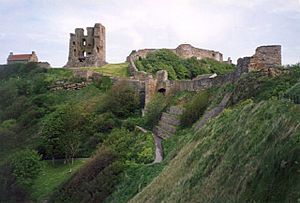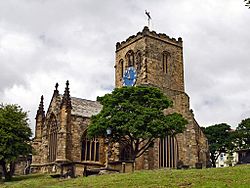Great Siege of Scarborough Castle facts for kids
Quick facts for kids Great Siege of Scarborough Castle |
|||||||
|---|---|---|---|---|---|---|---|
| Part of the First English Civil War | |||||||
 Remains of Scarborough Castle |
|||||||
|
|||||||
| Belligerents | |||||||
| Commanders and leaders | |||||||
| Sir Hugh Cholmley William Nesfield |
John Meldrum (DOW) Sir Matthew Boynton |
||||||
| Strength | |||||||
| 500 | 1700 | ||||||
| Casualties and losses | |||||||
| c.475 killed or wounded | Unknown | ||||||
The Great Siege of Scarborough Castle was a huge fight for control of an important stone fortress in England. It happened during the First English Civil War. This war was fought between the Parliamentarians and the Royalists. The Royalists were loyal to King Charles I.
In February 1645, the Parliamentarians started a siege of Scarborough Castle. A siege means they surrounded the castle to try and force those inside to give up. For five months, they attacked the castle with cannons. They destroyed most of the castle's main tower, called the keep. There was also a lot of fierce fighting. Finally, the defenders inside the castle surrendered.
This was an important win for the Parliamentarians. However, it wasn't the last time the castle changed hands. There was a second, smaller siege in 1648. The new soldiers inside the castle switched sides during that time. The castle finally stayed under Parliamentarian control from 1649. It remained theirs until the King returned to power in 1660. The castle actually changed hands seven times between 1642 and 1648!
Contents
Why Was Scarborough Castle Important?
At the start of the English Civil War, Scarborough town and its castle were held by Parliament. Sir Hugh Cholmley was in charge. But in March 1643, he decided to switch sides and support the King.
Cholmley actually lost the castle briefly to his own cousin, Captain Browne Bushell. This happened in the same month while Cholmley was away. But he convinced his cousin to give it back. Cholmley then ordered the castle to be made stronger. This included building a new battery for cannons.
A Stronghold for the King's Supporters
After March 1643, Sir Hugh Cholmley was the only Royalist leader in his area. But his forces felt very safe at Scarborough. They could move around the region almost freely. They attacked Parliamentarian positions. For example, in May, Cholmley's cavalry (soldiers on horseback) raided a Parliamentarian's estate. In June, Cholmley captured a marketplace far from the castle. He also helped in an unsuccessful siege of Hull later that year.
Cholmley's actions were annoying to the Parliamentarians. But the King's strongholds in the southwest were seen as more important. However, Scarborough became a big problem because of piracy. The port was a safe place for Royalist ships. These ships attacked and robbed other ships carrying coal to London. This became a bigger worry as winter came. The port also allowed the Royalist armies to bring in weapons.
Parliamentarian Victories and Royalist Retreat
The Royalists failed to capture Hull. Also, Scottish soldiers joined the war on Parliament's side in late 1643. This led to many Parliamentarian victories in Yorkshire. On July 2, 1644, the Parliamentarians and Scots won a huge battle. It was called the Battle of Marston Moor.
The next day, a top Royalist general, the Marquess of Newcastle, fled England. He and other officers left from Scarborough by ship. They abandoned the fight. Two weeks later, the city of York surrendered. Scarborough was then the most important Royalist base left in Yorkshire. But many of Cholmley's soldiers left. The castle also started to fall apart.
In August, a Parliamentarian force led by Lord Fairfax reached the town. Cholmley pretended to negotiate a surrender. This bought him time to improve the castle's defenses. It allowed him to hold out for another year.
The Great Siege Begins
On February 18, 1645, Sir John Meldrum led 1700 Parliamentarian soldiers. They took the town of Scarborough. They had almost no injuries. They also captured the South Steel Battery and the port. This meant the Royalists inside the castle could not escape by land or sea. Cholmley and his men retreated into the castle. He refused to give up.
So, the Parliamentarians got ready for a five-month siege. It would be one of the bloodiest of the civil war. There was fighting almost every day.
At first, Parliament wasn't very interested in the castle. They had the port, which was their main goal. Meldrum had to ask other ports for money. He warned them that Royalist pirates like Bushell might attack their supply ships. Over several weeks, money slowly came to Scarborough. This allowed Meldrum to get the forces he needed for a full siege. Parliament then agreed that attacking the castle was important.
The siege was delayed for six weeks. This was because Meldrum fell over a cliff on March 24. Cholmley said Meldrum was trying to get his hat back from the wind. But it's more likely a strong gust of wind blew him off. Meanwhile, the soldiers inside the castle had drinking water from local springs. They also had a well near the cliff. With their stored food, they could defend the castle for months.
Attacking the Castle Walls
When Meldrum returned in May, the Parliamentarians set up a huge cannon. It was called the "Cannon Royal." They placed it in the old St. Mary's Church below the castle. This cannon fired heavy cannonballs that weighed about 56 to 65 pounds. These balls pounded the castle's defenses.
The Royalists fired back with their own cannons. St. Mary's Church was badly damaged over three days of fighting. Part of it is still a ruin today. Records say Cholmley "did great mischief to St. Mary's." But it's more likely the Parliamentarian cannons caused more damage. The church building was already old and decaying.
The bombardment partly destroyed the castle's main tower, the keep. Its west wall, roof, floors, and stairs all collapsed. However, the outer walls of the castle were not broken. So, the Parliamentarians could not take the castle right away. In fact, they had accidentally given the defenders a large pile of rubble. This rubble could be used for cover and even as ammunition.
Meldrum didn't realize that the Royalists were cut off from the castle entrance (called the barbican). The rubble blocked their way. So, he didn't try to take the entrance until it was too late. The Royalists had already cleared a path and taken control again. Meldrum was only able to capture Bushell's cannon battery. He then set up 34-pound cannons there. These cannons aimed at the castle yard.
On the night of May 10, the Royalists attacked the artillery battery. They destroyed it. The Parliamentarians retreated in a mess, losing many soldiers. The next day, there was very bloody hand-to-hand fighting around the barbican gateway. Neither side took prisoners. Sadly, Meldrum was badly wounded and later died.
The Castle Gives Up
By July 1645, the Parliamentarians were winning the war. Sir Matthew Boynton took over from Meldrum. He decided to attack the castle with cannons from land and sea. He did not want to send more soldiers to fight on foot.
The constant cannon fire, a disease called scurvy, and a lack of water weakened the defenders. They might also have run out of gunpowder. The threat of starvation meant the castle had to surrender. This happened at noon on July 25. Only 25 defenders were left who could still fight. Fewer than half of the original 500 soldiers survived. The townspeople were not happy to see them. They had suffered a lot during the siege.
Perhaps to end the fighting quickly, Cholmley received very good surrender terms. He left England and went to live in Holland.
What Happened After the Siege?
The castle was repaired and given new weapons for Parliament. A company of 160 soldiers was placed there. But these soldiers were not paid. So, the castle went back to Royalist hands. Matthew Boynton, the new governor, declared his support for the King on July 27, 1648.
This led to a second siege. The castle came back under Parliament's control on December 19. The soldiers inside were defeated as much by the coming winter as by Parliament's forces. After this, the castle was supposed to be destroyed. This was ordered in July 1649. The goal was to stop it from being used by Royalists again. But local people protested. Also, there were new fears that Royalists might try to take Scarborough again. Dutch ships even appeared in the harbor.
So, the castle was not destroyed. Instead, it was used as a prison. People who were seen as enemies of the Commonwealth of England were held there. The Commonwealth was England's short time as a republic, without a king. The main tower, the keep, still stands today, but its west wall is gone. The castle was given back to the King when the monarchy returned in 1660.


